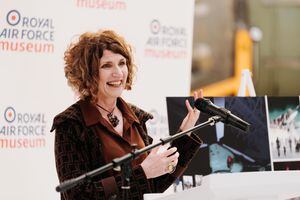Veteran reunited with famous Bravo November helicopter as it prepares for display at RAF Cosford
A veteran of the Iraq War has been reunited with one of the conflict's most famous helicopters after it arrived ready to be displayed at RAF Cosford.

Squadron Leader Steve Carr was awarded a Distinguished Flying Cross (DFC) medal for his service on the RAF Chinook HC6A, known as 'Bravo November' and famed for action at conflicts from the Falklands to the Gulf.
The Chinook is the latest addition at the RAF museum at Cosford and will become a permanent fixture on display for visitors from April 2, which marks the anniversary of the start of the 40th anniversary of the start of the Falklands War.
During its long career, the helicopter earned four DFC medals, the first being for action in the 1982 conflict in the South Atlantic between Argentina and Great Britain.
Squadron Leader Carr was awarded a DFC for his service on Bravo November in Iraq and was among a select group at the unveiling of the Chinook in Cosford on Tuesday.


He said: "I flew her for the first time in the early 2000s and my main connection was during the second Gulf War, leading five aircraft into oil refineries to secure them.
"It has a history which started in the Falklands and that lead it into Iraq as the decision was made for it to lead as it was already famous from the 1982 conflict, and I think many people are delighted it's making Cosford its home as it is in a good place."
A small group of invited guests with close links to the twin-rotor helicopter - which also saw action in Afghanistan, Iraq and Northern Ireland during 39 years of service - were present to view Bravo November in its new display position.
They had the chance to go inside the chopper and heard speeches from Air Chief Marshal Sir Andrew Pulford and Dr Peter Johnston and Maggie Appleton, who are both from the museum.


Bravo November was delivered to the museum between Wolverhampton and Shifnal from RAF Odiham in Hampshire over five days and is one of the 30 original Chinooks ordered by the RAF in 1978 at a cost of approximately £100 million.
Ms Appleton, the CEO of the museum, said it was an emotional moment to have such an historic aircraft with so many stories to tell at the RAF Cosford museum.
She said: "For us, as we're all about storytelling, having Bravo November here to share stories in a powerful way is extraordinary and while it's sad that she's finished a working life, there is the joy of having her here to continue telling her story for years to come.
"When you start to hear that story of the only Chinook to survive the Atlantic convoys being sunk and four of her crew having the Distinguish Flying Cross, it's just an extraordinary story and one that's shouting out to be told.
"We'll be wrapping some storytelling around her over the next few weeks and Bravo November will be a star of the show we will be telling about the Falklands conflict."

Bravo November earned its place in RAF history at the start of the Falklands campaign in April 1982, when it was being transported along with three other Chinooks to the South Atlantic on the container ship MV Atlantic Conveyor.
The ship, along with its cargo, was destroyed by an Exocet missile, but Bravo November was airborne at the time, collecting cargo from HMS Glasgow, and managed to land on HMS Hermes, gaining the nickname The Survivor.
It was the only serviceable heavy lift helicopter available to British forces involved in the hostilities, and was used to carry some 1,500 troops, 95 casualties and 650 prisoners of war, as well as 550 tons of cargo.
Squadron Leader Dick Langworthy was another pilot awarded a DFC for his bravery at the controls of the Chinook, which had the serial number ZA718.

Bravo November was on a night mission in the Falklands when pilot Squadron Leader Langworthy and his co-pilot Flight Lieutenant Andy Lawless descended after losing visibility in a thick snow shower, hitting the sea at about 100 knots (115mph) due to a faulty altimeter.
The impact threw up spray that flooded the engine intakes but Langworthy and his co-pilot managed to get the helicopter back in the air. The fuselage was damaged, an antenna had been lost and the co-pilot's door had been torn away leaving the crew unable to navigate or communicate with other forces.
Nonetheless Bravo November made it back to San Carlos for damage inspection.

Dr Peter Johnston, head of collections and research, worked to bring Bravo November to Cosford and said it was a wonderful opportunity to help people learn about the Falklands War.
He said: "For us, it's wonderful to bring this aircraft that people might not know about and let them know that the RAF was in Falklands and they played an important part, which is sometimes overlooked.
"I'm excited to have this here as it's the last survivor of the war and also flew on for decades afterwards and it is incredibly rare to find an aircraft that that has gone through so much and you can see the affection people still have for it."
Bravo November will go on display to the public on Saturday, April 2, the 40th anniversary of the start of the Falklands War.





